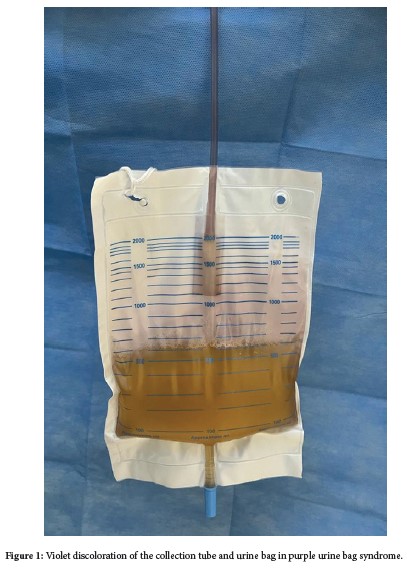2376-0249
Clinical-Medical Image - International Journal of Clinical & Medical Images (2023) Volume 10, Issue 8

Author(s): Chafiq Kamal*, Hadzine Youssef, Elmekkaoui Adel, Benlenda Othmane and Nassik Hicham
Department of Anesthesiology and Resuscitation, University Ibn Zohr, Agadir, Morocco
Received: 07 August 2023, Manuscript No. ijcmi-23-109660; Editor assigned: 08 August 2023, Pre QC No. P-109660; Reviewed: 14 August 2023, QC No. Q-109660; Revised: 16 August 2023, Manuscript No. R-109660; Published: 23 August 2023, DOI:10.4172/2376-0249.1000907
Citation: Kamal C, Youssef H, Adel E, Othmane B and Hicham N. (2023) What does a Purple Discoloration of Urine Mean?. Int J Clin Med Imaging 10: 907.
Copyright: © 2023 Kamal C, et al. This is an open-access article distributed under the terms of the Creative Commons Attribution License, which permits unrestricted use, distribution and reproduction in any medium, provided the original author and source are credited.
A 74-year-old female patient was admitted to the intensive care unit for the management of complicated polytrauma accompanied by septic shock. Violet discoloration appeared on the 4th day after the insertion of a urinary catheter. Cytobacteriological and biochemical analysis of the urine showed normal results, with no isolated microorganisms in culture. The Purple Urine Bag Syndrome (PUBS) is an unusual and rare medical condition, first described in 1978 by Barlow and Dickson [1]. This syndrome primarily affects elderly bedridden women who suffer from constipation, have a permanent catheter in place and frequently have urinary tract infections, with an estimated prevalence of 11.7% [2,3]. As the name suggests, it is characterized by the violet hue that develops in the urinary catheter and/or the urine collection bag (Figure 1). The origin of the violet color is linked to the metabolism of tryptophan in the gastrointestinal tract (facilitated by constipation), leading to the synthesis of indole by intestinal microbiota. This compound is then absorbed and enters the portal circulation to reach the liver, where it is transformed into 3-hydroxy-indole and subsequently into indoxyl sulfate (indican). Indican is excreted in the urine, where, under the action of bacterial enzymes (sulfatase, phosphatase), it can be converted into indirubin (red) and indigo (blue). The combination of these two compounds in the urinary pouch results in the characteristic violet color [4]. PUBS does not always indicate the presence of a urinary tract infection.
Purple urine bag syndrome; Urinary catheter
None of the authors have any conflict of interest to disclose.
[1]Barlow GB and Dickson JAS. (1978). Purple urine bags. Lancet 311: 220-221.
Google Scholar, Crossref, Indexed at
[2]Jappi Y. and Hadi U. (2023). Purple urine bag syndrome in urinary tract infection. J Glob Infect Dis 15: 84.
Google Scholar, Crossref, Indexed at
[3]Llenas-García J, García-López M, Pérez-Bernabeu A, Cepeda, JM. and Wikman-Jorgensen P. (2017). Purple urine bag syndrome: A systematic review with meta-analysis. Eur Geriatr Med 8: 221-227.
Google Scholar, Crossref, Indexed at
[4]Chamutu M, Traore YJRP, Ziba OJD, Valimunghe MM and Basirwa FM, et al. (2022). Violet urine bag syndrome: About a case at Saint Camille Hospital in Ouagadougou (HOSCO). KisMed Jun 12: 584-587.
 Awards Nomination
Awards Nomination

